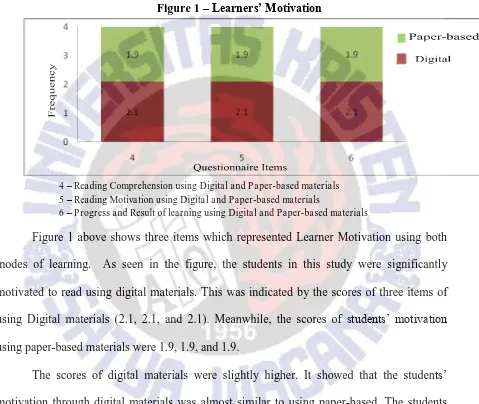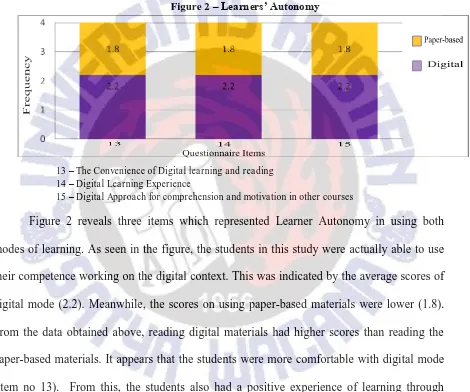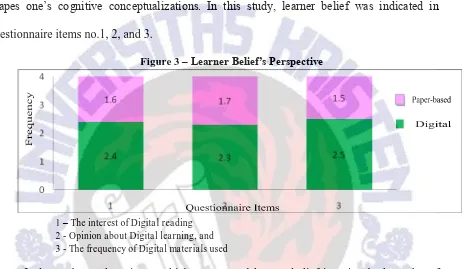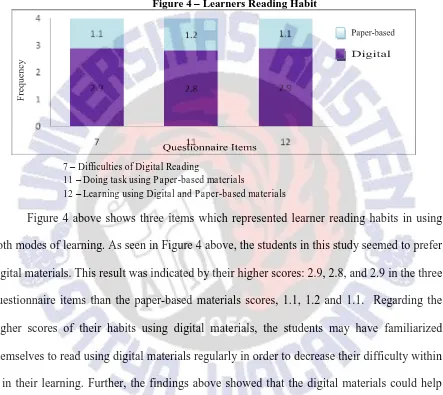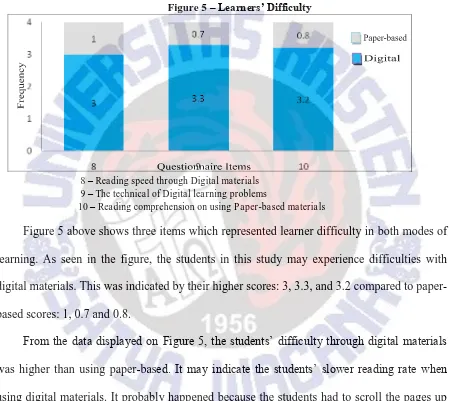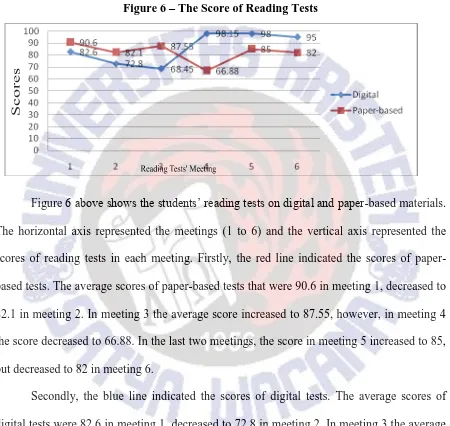STUDENTS’ PERCEPTION ON USING DIGITAL AND PAPER
-BASED
MATERIALS FOR SENIOR HIGH SCHOOL STUDENTS IN
SALATIGA
THESIS
Submitted in Partial Fulfillment
of the Requirements for the Degree of Sarjana Pendidikan
Anita Dwi Sukmawati
112009056
ENGLISH DEPARTMENT
FACULTY OF LANGUAGE AND LITERATURE
SATYA WACANA CHRISTIAN UNIVERSITY
SALATIGA
ii
STUDENTS’ PERCEPTION ON USING DIGITAL AND PAPER
-BASED
MATERIALS FOR SENIOR HIGH SCHOOL STUDENTS IN
SALATIGA
THESIS
Submitted in Partial Fulfillment
of the Requirements for the Degree of Sarjana Pendidikan
Anita Dwi Sukmawati
112009056
ENGLISH DEPARTMENT
FACULTY OF LANGUAGE AND LITERATURE
SATYA WACANA CHRISTIAN UNIVERSITY
SALATIGA
iv
COPYRIGHT STATEMENT
This thesis contains no such material as has been submitted for examination in any course or accepted for the fulfillment of any degree or diploma in any university. To the best of my knowledge and my belief, this contains no material previously published or written by any other person except where due reference is made in the text.
Copyright@ 2013. Anita Dwi Sukmawati and Pro. Dr. Gusti Astika M.A.
All rights reserved. No part of this thesis may be reproduced by any means without the permission of at least one of the copyright owners of the English Department, Faculty of Language and Literature, SatyaWacana Christian University, Salatiga.
1
STUDENTS’ PERCEPTION ON USING DIGITAL AND PAPER
-BASED
MATERIALS FOR SENIOR HIGH SCHOOL STUDENTS IN
SALATIGA
Anita Dwi Sukmawati
Abstract
The development of technology has brought a new innovation in the language learning process. Inspired by the progress in CALL, this study attempted to study students‘ perception on using digital and paper-based materials. This study used a questionnaire and reading tests. The finding shows students that the students had positive perceptions to learn English using Digital materials in order to develop their reading competence in English.
Keywords: Technology in language learning, Digital and Paper-based materials, CALL
Introduction
Indonesian students nowadays can read texts in English as a foreign language in
different modes. Reading is usually defined as the process of receiving and interpreting
information encoded in the language form via the medium of print (Urquhart & Weir,1998;22
as cited in William Grabe, 2009 ). When they read English texts comprehension is important,
it occurs when the reader extracts and integrates various information from the text and
combines it with what is already known (Koda 2005:4 as cited in Grabe, 2009). Students read
texts to communicate and interact in creating or constructing meaning. Following the
development of technology, there is a change of literacy type of reading texts from the
printed-texts to computer-based ones, such as CALL.
CALL which stands for Computer Assisted Language Learning, as Levi (1997, cited
in Fard & Nabifar, 2011) describes ―a field that covers ―the search for and study of
application of the computer in language teaching and learning process‖. The word assisted
indicates that technology is a tool to facilitate learning. Many institutions, universities, and
even companies have enhanced their process of English learning on using CALL (Alsagheer,
2
learning environment. Yet, the implementation of texts using digital and paper-based
materials for language learning is still unclear.
Some research produced different findings about how CALL takes the place of
English texts to build students‘ comprehending effectively. Some research has shown the
effectiveness of CALL to support learning. Such as that the study conducted in UAE for 60
elementary-prep school students. It showed a significant difference of achievement between
CALL users and non users in learning EFL (Almekhlafi, 2006).
Following the development of technology, the form of English texts are transformed
into the digital ones. Digital texts, according to Dillon (1992), are viewed from a screen such
as a computer monitor. Very specifically, Gunes (2009a; 2009b) cited in Zeynep and Ergun
(2012); stated that the characteristic of digital text is the presentation of a certain portion of
printed texts from a screen. This format is implemented to create teaching and learning
process of English, especially in increasing students‘ abilities in four skills of English –
listening, reading, writing and speaking; to be more effective. Research by Zeynep and Ergun
(2012) reported the effect of reading from the screen on the reading for 60 students of
elementary 5th graders. The analysis showed significant results of students who were working
with printed materials and from screen. The uses of CALL in reading comprehension for
students of British Higher Education Institution (HEI) presented a good benefit for the
students‘ development of reading comprehension on texts. This finding explained that the
students preferred more with a digital text format rather than in Paper-based one.
Those studies lead me to design a study on students‘ perception on using Digital and
Paper-based materials in reading. The question was; What are the students‘ perceptions on
using Digital and Paper-based materials for students of SMAN 1 Salatiga? The aim was to
describe the students‘ perception to read using Digital and Paper-based materials in
3 Literature Review
Reading is usually defined as the process of receiving and interpreting information
encoded in the language form via the medium of print (Urquhart & Weir, 1998; 22). To
improve students‘ reading, the use of paper-based materials (or printed ones) is still
dominant. On the other hand, the development of technology has brought a new innovation
and transformation in language learning process. This new innovation is applied through
Digital, especial the use of computer for supporting the learning. The use of computer to
assist learners in their language studies has increased phenomenally over the past decade
(Liddell, 1994 cited in Ayres, 2002). The number of research showed that the utility of EFL
literacy format has transformed continuously, such as that with the use of CALL.
More currently Egbert (2005, p. 4) defines CALL as ‗‗learners learning language in
any context with, through, and around computer technologies. Very specifically, according
to Wikipedia encyclopedia (2005) in CALL Essential Book written by Egbert (2005), CALL
is defined as an approach to language teaching and learning on using Digital form. The use of
computer is as an aid to the presentation, reinforcement, and assessment of material to be
learned, usually including a substantial interactive element. CALL can build an optimal EFL
classroom language learning environment.
Computer-Assisted Language Learning (CALL) is an increasingly important part of
the language learning process (Tschirner, 2001 as cited in Ayers, 2002). The word assisted
indicates technology only becomes a tool to facilitate learning for drilling and practicing;
generating the understanding of texts, and integrating the various skills and technology in
learning process (Warschauer &Healey, 1998, as cited in Kledecka, 2001). Some findings
showed the use of CALL brought significant effects to EFL learning process. For example, In
research finding written by Jafarian, Soori & Kafipour (2012), the implementation of CALL
effected students‘ writing skill shown from the higher achievement of CALL users than
4
Mulholland (2006) investigated the use of technology to improve written language skill for
non-native English speaker. More to the point, the students using email could not
demonstrate any improved written language ability balance like on using a word processing
program. On the other hand, Sun and Dong (2004) cited on Ward & Mulholland (2006);
conducted a study on how multimedia assists English vocabulary learning in 7-year-old
Chinese learners. The finding was without the support of native language or scaffolding of
learning, multimedia did not bring benefit for young English learners. However, by having
sentence-level translation and scaffolding provided, the participants‘ scores improved. From
those studies, the role of technology above has reflected that the role of CALL brings
different effects and benefits in improving students‘ knowledge and competency in EFL.
Concerning the development of technology, one factor that has to be paid attention is
to support learners capability in learning English. These factor relates to the learners‘ belief
guided by their behaviour about the benefits and difficulties in using technology . As Kregor,
Breslin and Fountain (2012) explained, the factor is self-efficacy, or an individual‘s
perceptions about their own capability in using the system (Lewis, et al., 2003; Liaw, Huang
& Chen, 2007; Pituch & Lee, 2006), perceptions of technology functionality and quality
(Pituch & Lee, 2006; Sun, et al., 2008), or perceptions of social support (Nicolle & Lou,
2008; Swan, 2001). Analysing these external factors, as well as the attitudes and beliefs
created by them, is the first step towards understanding users‘ behaviour stated by Kregor,
Breslin and Fountain (2012).
In addition, technology can promote students‘ motivation and autonomy which has an
important role in increasing students‘ learning. According to Majid (2011), motivation is
important to encourage students‘ learning. In learning English, technology is able to get the
students‘ attention towards learning materials and exercises. Technology can deliver good
authentic illustrations of the real-world to make students aware of the values and benefits that
5
learning activities (Roblyer, 2006 cited in Majid, 2011). By considering the motivational
impacts in learning process, it can make the students to be more independent. As Harmer
(2007) cited in Majid (2011) stated motivational impacts obviously create students‘
autonomy towards amount of motivation in. Additionally, autonomy is an important
educational goal. As it is often claimed, there is a close connection between learners‘
autonomy and effective learning (Chia, 2007).
Analyzing the important role of motivation and autonomy in language learning
process, it has to be considered how the traditional learning using paper-based materials is
collaborated with technology in the teaching and learning process. According to Shi (2008)
cited in Shyamlee & Phil (2012), the purpose of both the traditional and computer-assisted
cooperative language leaning classrooms is to provide a space in which the facilitation of
learning, and learning itself, can take place.
To make Digital modes more interesting in the classroom, the use of paper-based
materials in suppotring learners ability can be transformed into the digital one. Jones (2001)
cited in Egbert (2005)stated that computer-based instruction currently has become the highest
interactive learning for activities which can develop the students‘ skill. In Savage & Vogel‘s
study (1996) cited in Zimmer (2013) about multimedia in English Language Teaching, the
use of LCD can enthuse the students ready to concentrate on what is going to be taught,
convey the information quickly and effectively and keep them interested in learning.
For students who are leaning English as a Foreign Language, reading becomes an
essential skill to master in order to achieve success in learning English (Anderson, 2003 cited
in Grabe (2009). On the other hand, there are still many learners of English as a foreign
language have a major difficulty of reading comprehension which has often happened in all
classes. They contended that poor concentration skill in dealing with lengthy and deep textual
reading; have a superficial understanding of issue and also due to the lack of depth in reading
6
According to Biancarosa & Snow (2006) in the Reading Next report, ―Very few older
struggling readers (between fourth and twelfth grade) need help to read the words on a page,
their most common problem is that they are not able to comprehend what they read‖.
In line with the progress in CALL, many Indonesian schools have been adapting the
technology in English teaching and learning. Unfortunately, the study of reading from
paper-based and the digital materials is very rare. This study intended to describe students‘
perception to read using digital and paper-based materials in improving their reading skill.
The data were gathered from the result of a Likert scale questionnaire and reading tests using
different modes; digital and paper-based.
The participants were ten students of senior high school in Salatiga, five males and
five females. The participants were selected by their English teacher because the students
were considered having experiences to read using digital and paper-based materials.
This study aimed to obtain students‘ perception about reading comprehension using
Digital and Paper-based materials. To gather information from the participants, this study
used a questionnaire and reading tests for two different types of reading texts. First, the tests
were conducted twelve times for a week to measure students‘ comprehension by reading
twelve descriptive texts. The texts were taken from their regular texts. Besides, each test was
conducted in two different versions, digital, then paper-based version.
The questionnaire in this study was written in Bahasa Indonesia adapted from
7
participants filled in the questionnaire by selecting the options: 4 (strongly agree), 3 (agree), 2
(disagree) and 1 (strongly disagree).
The data collection of this study was carried out into two phases, through reading tests
and a questionnaire. At the beginning of collecting the data, the students did twelve tests
through digital and paper- based materials. Every test had a different topic and difficulty
level. After the tests, the questionnaire was distributed.
From the data obtained, the first analysis was from the result of questionnaire. The
scores of each item were tabulated into a table. Then, those scores were calculated to find out
the average scores. After that, the average scores were categorized into five categories. The
first category was Learner Motivation which comprised items no 4, 5 and 6. The second
category was Learner Autonomy, items no. 13, 14, and 15. The third category was Learner
Belief. This category comprised items no. 1, 2 and 3. The fourth category was Learner
Reading Habit, items no. 7, 11 and 12. The last category was Leaner Difficulty, items no. 8, 9
and 10. After that, the graphs were prepared for each category with the average scores.
Another finding was from the reading tests. Firstly, the average of test scores were
tabulated showing the pairs of digital and paper-based tests‘ scores. The pairs of scores were
put in a line graph showing the progress of students‘ reading skills.
Findings and Discussions
The purpose of this study was to describe the students‘ perception to read using
Digital and Paper-based materials. In this study, the results were obtained from the scores of
questionnaire and the reading tests. The questionnaire items were categorized into five
categories: (1) Learners‘ Motivation, (2) Learners‘ Autonomy, (3) Learners‘ Belief, (4)
Learners‘ Reading Habit, and (5) Learners‘ Difficulty. Another finding was Learner
8 1. Learner Motivation
Leaner motivation in this study is displayed in Figure 1 below. According to Grabe
(2009), motivation refers to the students‘ cognition which involves a set of belief, values and
expectation which lead them to gain competence through cognitive monitoring and strategy
process for learning. In this study, motivation to read using digital and paper-based materials
was indicated in questionnaire items no 4, 5 and 6.
Figure 1 –Learners’ Motivation
4 – Reading Comprehension using Digital and Paper-based materials 5 – Reading Motivation using Digital and Paper-based materials
6 – Progress and Result of learning using Digital and Paper-based materials
Figure 1 above shows three items which represented Learner Motivation using both
modes of learning. As seen in the figure, the students in this study were significantly
motivated to read using digital materials. This was indicated by the scores of three items of
using Digital materials (2.1, 2.1, and 2.1). Meanwhile, the scores of students‘ motivation
using paper-based materials were 1.9, 1.9, and 1.9.
The scores of digital materials were slightly higher. It showed that the students‘
motivation through digital materials was almost similar to using paper-based. The students
probably had equal comprehension skills in both modes of learning. Further, the students‘
progress and result to read using digital and paper-based materials were not much different. It
could be assumed that the students had similar motivation using both materials in learning
English. Regarding motivation for learning English, digital materials could probably increase
9 2. Learner Autonomy
The second category in this study focused on learners‘ autonomy which is displayed
in Figure 2. Learner Autonomy as stated by Benson (2001:1) and Little (1991:4), cited in
Chia (2007), is recognized as an important educational goal. They also pointed out that
learner autonomy refers to the wide-ranging capacity approaches that the learners use to
process their learning. In this study, the learner Autonomy in using Digital and Paper-based
materials was indicated in questionnaire items no 13, 14, and 15.
Figure 2 –Learners’ Autonomy
13 – The Convenience of Digital learning and reading 14 – Digital Learning Experience
15 – Digital Approach for comprehension and motivation in other courses
Figure 2 reveals three items which represented Learner Autonomy in using both
modes of learning. As seen in the figure, the students in this study were actually able to use
their competence working on the digital context. This was indicated by the average scores of
digital mode (2.2). Meanwhile, the scores on using paper-based materials were lower (1.8).
From the data obtained above, reading digital materials had higher scores than reading the
paper-based materials. It appears that the students were more comfortable with digital mode
(item no 13). From this, the students also had a positive experience of learning through
digital mode to process their learning functionally (item no 14). Besides, the digital materials
were probably applied in other courses to encourage students‘ independent learning (item no
10
the digital materials could develop connection between students‘ autonomy and effective
learning (Chia, 2007).
3. Learner Belief
Learner Beliefs in this study is displayed in Figure 3. According to Fishbein & Ajzen,
(1975); Ajzen (1988), and Breen (2001), as cited in Inna (2005), belief is a central construct
in every discipline that deals with the students‘ behavior and learning which affects and
shapes one‘s cognitive conceptualizations. In this study, learner belief was indicated in
questionnaire items no.1, 2, and 3.
Figure 3 –Learner Belief’s Perspective
1 – The interest of Digital reading 2 - Opinion about Digital learning, and 3 - The frequency of Digital materials used
Figure 3 above shows three items which represented learner belief in using both modes of
learning. As seen in the figure, the students in this study showed higher scores for their belief
to using digital materials. This was indicated by the average scores of Digital materials; 2.4,
2.3, and 2.5 compared to those of paper-based materials; 1.6, 1.7 and 1.5. The students
probably had stronger belief using digital materials than paper-based ones, hence they used it
more frequently as indicated in item 3. From this, it could be assumed that the students
strongly believed in their own capability to use digital learning in EFL classroom activities
11 4. Learner Reading Habit
Learner Reading Habit in this study is displayed in Figure 4 below. As taken from
Encarta world English Dictionary (2000), Learner Reading Habit refers to things that students
do regularly and repeatedly. There is tendency that he or she becomes unconscious in doing
the activity. In this study, Learner Reading Habit to read using Digital and Paper-based
materials was indicated in questionnaire items no. 7, 11 and 12.
Figure 4 – Learners Reading Habit
7 – Difficulties of Digital Reading
11 – Doing task using Paper-based materials
12 – Learning using Digital and Paper-based materials
Figure 4 above shows three items which represented learner reading habits in using
both modes of learning. As seen in Figure 4 above, the students in this study seemed to prefer
digital materials. This result was indicated by their higher scores: 2.9, 2.8, and 2.9 in the three
questionnaire items than the paper-based materials scores, 1.1, 1.2 and 1.1. Regarding the
higher scores of their habits using digital materials, the students may have familiarized
themselves to read using digital materials regularly in order to decrease their difficulty within
it in their learning. Further, the findings above showed that the digital materials could help
students to concentrate and understand information effectively. According to Savage &
Vogel, 1996 cited in Zimmer, 2013, digital materials could sustain students‘ interest in
12 5. Learners’ Difficulty
Learner Difficulty in this study is displayed in Figure 5 below. The word difficulty
refers to inability of the students in dealing with lengthy and deep textual reading. The
students may also have a superficial understanding of issues in reading especially using
digital materials (Sutherland-Smith, 2002). In this study, the difficulty to read using digital
materials was indicated in questionnaire item no. 8, 9, and 10.
Figure 5 –Learners’ Difficulty
8 – Reading speed through Digital materials 9 – The technical of Digital learning problems
10 – Reading comprehension on using Paper-based materials
Figure 5 above shows three items which represented learner difficulty in both modes of
learning. As seen in the figure, the students in this study may experience difficulties with
digital materials. This was indicated by their higher scores: 3, 3.3, and 3.2 compared to
paper-based scores: 1, 0.7 and 0.8.
From the data displayed on Figure 5, the students‘ difficulty through digital materials
was higher than using paper-based. It may indicate the students‘ slower reading rate when
using digital materials. It probably happened because the students had to scroll the pages up
and down repeatedly which actually made them lose concentration. They often had technical
problems while reading digital materials. Regarding the students‘ difficulty on using digital
materials, the students still needed help to improve their poor concentration and
13
6. Learners’ achievement in the Reading Tests
The last finding in this study was gathered from the analysis of Reading tests scores.
The tests asked the student to read using both digital and paper-based materials twelve times
in six meetings. It means that the students had two different test modes. The result of the tests
is described in Figure 6 below.
Figure 6 – The Score of Reading Tests
Figure 6 above shows the students‘ reading tests on digital and paper-based materials.
The horizontal axis represented the meetings (1 to 6) and the vertical axis represented the
scores of reading tests in each meeting. Firstly, the red line indicated the scores of
paper-based tests. The average scores of paper-paper-based tests that were 90.6 in meeting 1, decreased to
82.1 in meeting 2. In meeting 3 the average score increased to 87.55, however, in meeting 4
the score decreased to 66.88. In the last two meetings, the score in meeting 5 increased to 85,
but decreased to 82 in meeting 6.
Secondly, the blue line indicated the scores of digital tests. The average scores of
digital tests were 82.6 in meeting 1, decreased to 72.8 in meeting 2. In meeting 3 the average
score decreased to 68.45, however, in meeting 4 the score increased to 98.15. In the last two
meetings, the score in meeting 5 was 98 and decreased to 95 in meeting 6.
The scores of paper-based materials in meeting 1 to 3 were higher than the digital ones.
14
of paper-based tests. It could be assumed that the students reading skills through digital
materials were developing in the last three tests. The students‘ progress above may indicate
that their comprehension skill was better because of frequency of using the digital mode of
reading. From this, it could be assumed that digital mode of learning could create interactive
learning activities which could develop students‘ ability in English (Jones, 2011).
Conclusion and Recommendation
The purpose of this study was to describe students‘ perception to read digital and
paper-based materials in English. The finding in this research study revealed important points
related to students‘ reading ability by analyzing the result of questionnaire and also the scores
of reading tests in both modes. Based on the result of questionnaire, the students‘ perception
was categorized into 5 categories: Learner Motivation, Learner Autonomy, Learner Belief,
Learner Reading Habit and Learner Difficulty. The analysis shows the digital materials have
resulted in positive learning experience. By using digital materials, they developed students‘
interest and motivation to be more independent learners. Their comprehension also improved
through digital materials. Another finding was obtained from the scores of reading tests. The
scores of paper-based tests were more dominant in the early meetings, but the scores of
digital tests increased significantly in the last three tests.
To conclude, this study found that the students had a positive perception of using
digital materials. The digital materials have motivated, encouraged and assisted students‘
reading skill in English. As a recommendation, this study proposes that the teacher needs to
provide digital materials regularly. For example, the teacher may ask the students to read
digital materials in a language laboratory. Digital materials can also be used as assignments.
The materials can be uploaded on to digital networking such as blogs or social networking.
The students can download the materials whenever and wherever they are by using their
15
Acknowledgement
First of all, I would like to thank to Jesus Christ for all His blessing, joy and strength in my
lifetime. Also, I would like to express my deepest gratitude to my thesis supervisor, Prof. Dr.
Gusti Astika, M. A. who was abundantly giving me valuable time, assistance, and guidance.
My gratitude is also due to my examiner, Dian Toar Y.G Sumakul, M.A for his willingness
to read and examine my thesis. I also thank Mrs. Dini and my participants in the Science
Program in SMA Negeri 1, Salatiga; for their precious contributions. The loveliest thanks
also go to my beloved family for the endless love and prayers throughout my study. For Mrs.
Irene Talakua, thank you for the support: ―Do the best and be a blessing‖. Also to all ED
Lectures, ED friends, NINERS‘ family, and my beloved best friends: Bima, Diane, Raras,
Krisma and Kak Citra, I would never forget every precious moment we have shared together.
God always be with you.
16
REFERENCES
Almekhlafi, A. G. (2006). The Effect of Computer Assisted Language Learning (CALL) on United Arab Emirates English as a Foreign Language (EFL) School Students‘
Achievement and attitude. Jl. of Interactive Learning Research (2006) 17(2),
121-142. 121-121-142.
Ayres, R. (2002). Learner attitudes towards the use of CALL. Computer Assisted Language
Learning Journal, 15(3), 241-249.
Biancarosa, C., & Snow, C. E. (2006). Reading next—A vision for action and research in
middle and high school literacy: A report to Carnegie Corporation of New York (2nd
ed.).Washington, DC: Alliance for Excellent Education.
Breen, (2001). Learners contribution to language learning. Pearson Longman
Chia, C. (2007). Autonomy in Language Learning : The Use of IT and Internet Resources.
The McGraw-Hill Education: NEI English Language and Literature Series.
Demerici, N. (2007). University Students‘ Perceptions of Web-based vs. Paper-based
Homework in a General Physics Course. Eurasia Journal of Mathematics, Science &
Technology Education, 3(1). 29-34
Dillon, A. (1992). Reading from paper versus screens: a critical review of the empirical
literature. Ergonomics, 35, 1297}1326.
Doddy, A ; Sugeng, Ahmad; & Effendi. (2008) Developing English Competencies for Senior
High School (SMA/MA) Grade X. Pusat Perbukuan : Departemen Pendidikan
Nasional.
Dyson, M. C & Haselgrove, M. (2001). The Influence of reading speed and line length on the
effectiveness of reading from screen. Department of Typography & Graphic, The
University of Reading, 2 Earley Gate, Whiteknights. 585-612.
Egbert, J., Paulus, T.M., & Nakamichi, Y. (2002). The impact of CALL instruction on classroom computer use: A foundation for rethinking technology in teacher
education. Language Learning and Technology, 6(3), 108-126.
Egbert, Joy. (2005). CALL essentials: principles and practice in CALL classrooms.
TESOL
Fard, H. E & Nabifar, N. (2011). The Effect of Computer-Assisted Language Learning
(CALL) on Reading Comprehension in Iranian EFL Context. Journal of Academic
and Applied Studies. Vol.1 (2) July, pp. 1-7
Grabe, W. (2009). Reading in Second Language: Moving from Theory to Practice.
Cambridge University Press.
17
Jafarian, Koorosh; Soori,Afshin; & Kafipour,Reza. 2012. The Effect of Computer
Assisted Language Learning (CALL) on EFL High School Students‘ Writing
Achievement. European Journal of Social Sciences. Vol.27 No. 2. Pp. 138-148.
Kledecka, Aleksandra & Nadera. (2001). Application of Computer Assisted Language
Learning in the Development of Reading Comprehension Skills. Poznan.
Kregor, G; Breslin, M; & Fountain, W. (2012). Experience and beliefs of technology users
at an Australian university: Keys to maximizing e-learning potential. Australian
Journal of Educational Technology.
Majid, Azis Nurkholis. (2011). The Use of Information Technology in Teaching English: An
Attempt to Develop Student-Centered Learning at Telkom Polytechnic. Prosiding
Konferensi Nasional ICT-M Politeknik Telkom (KNIP).
Nesselhauf, N., & Tschichold, C. (2002). Collocations in CALL: An investigation of
vocabulary-building software for EFL. Computer Assisted Language Learning 15(3)
251-279.
Pacuilla, H Silver & Ruedel, K. (2004). A Review of Technology-Based Approaches for
Reading Instruction :Tools for Researchers and Vendor. The National Center for
Technology Innovation.
Shyamlee, S.D & Phil, M. (2012). Use of Technology in English Language Teaching and
Learning: An Analysis. International Conference of Language, Medias and Culture
IPEDR. Vol. 33. IACSIT Press, Singapore
Sutherland-Smith, W. (2002) Weaving the literacy web: changes in reading from page to
screen, Reading teacher, vol. 55, no. 7, April, pp. 662-669.
Timucin, M (2006). Implementing CALL in EFL context. ELT Journal Volume 60/3.
Ward, H C & Mulholland, R. (2006). CALL Technologies: Survey Responses Concerning
University and School System‘s Responsibilities. The Reading Matriz. Vol 6, No. 3.
Zeynep and Dr. Ergun .(2012). The effects of Reading from the screen on the reading
motivation levels of elementary 5th graders. TOJET: The Turkish Online Journal of
Educational Technology. Volume 11 Issue 3.
18
APPENDIX A
The questionnaire items above were cited from Demirici , Neset (2007) about University Students’ Perceptions of Web-based vs. Paper-based Homework in General Physics Course. Eurasia Journal of Mathematics, Science & Technology Education, 3(1), 29-34
No Item Student ID Average
A B C D E F G H I J
1 Saya lebih tertarik membaca bacaan melalui
media Digital daripada melalui paper-based guna menambah pengetahuan
3 2 2 2 2 3 3 2 3 2 2.4
2 Menurut pendapat saya, belajar dengan media digital sangat tepat dalam proses belajar.
3 2 3 2 2 4 2 2 1 2 2.3
3 Saya lebih sering membaca bacaan dengan
media Digital daripada melalui paper-based.
2 2 2 2 2 3 3 3 3 3 2.5
4 Menurut saya, membaca bacaan melalui media digital sangat mudah dalam meningkatkan daya pemahaman saya.
2 2 2 2 2 3 2 2 2 2 2.1
5 Saya memiliki motivasi yang tinggi jika
menbaca bacaan melalui media Digital dibandingkan melalui paper-based.
2 2 2 2 2 3 2 2 2 2 2.1
6 Prestasi saya saat belajar bahasa Inggris dengan
menggunakan media Digital mengalami peningkatan.
2 2 2 2 2 3 2 2 2 2 2.1
7 Saya mengalami kesulitan untuk memahami
informasi saat membaca bacaan melalui media digital.
3 2 3 3 3 2 3 3 4 3 2.9
8 Saya membutuhkan waktu yang lama saat
membaca dengan menggunakan media digital daripada melalui paper-based.
4 2 2 3 4 1 4 3 4 3 3
9 Gangguan teknis pada komputer yang terjadi
sering menurunkan motivasi membaca dan daya pemahaman saya.
3 2 4 3 3 4 4 4 3 3 3.3
10 Saya dengan mudah memahami isi bacaan saat
membaca bacaan melalui paper-based.
4 2 3 3 3 2 4 3 4 4 3.2
11 Saya lebih suka mengerjakan tugas-tugas dengan
menggunakan media paper-based.
membaca melalui media digital daripada melalui media paper-based.
2 2 3 2 2 3 2 2 2 2 2.2
14 Menurut pendapat saya, membaca bacaan
dengan media digital merupakan pengalaman yang sangat positif dan saya akan selalu belajar dengan media tersebut untuk mengerjakan tugas dan menambah pengetahuan.
2 2 2 2 2 3 2 3 2 2 2.2
15 Menurut saya, belajar dengan media digital
sangat tepat untuk dipakai pada mata pelajaran lain guna meningkatkan daya pemahaman dan motivasi membaca.
19
Appendix B
The Average Scores from the Reading tests
